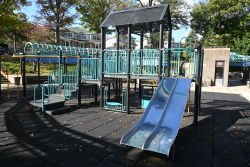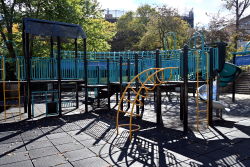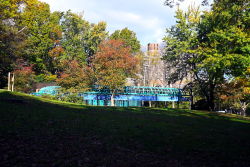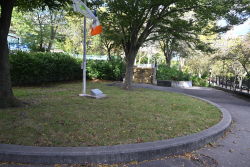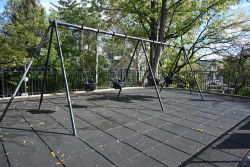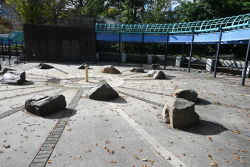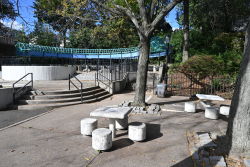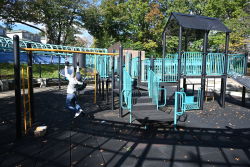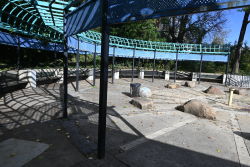Lt. Lia Playground
Lt. Lia Playground
This terraced park, with its dramatic views of the harbor and Manhattan, serves as a fitting tribute to local war hero Lieutenant Nicholas Lia (1944–1968), a Staten Island resident who was killed while serving in Vietnam. Lia, a graduate of Curtis High School and Wagner College, grew up in St. George near the park. A football player, Lia led the Wagner football team to an undefeated season. After graduating with distinction from Wagner, Lia enlisted in the U.S. Marine Corps officers training program. As lieutenant, he served two tours of duty in Vietnam as a tank commander, earning a Purple Heart and Gold Star. Lia was killed while placing a landmine in February 1968.
Located on Wall Street between St. Marks and Belmont Place in the Staten Island neighborhood of St. George, the park was originally mapped at this site in 1950. The site, then known as William T. Davis Park, was to be built in conjunction with a facility for the Staten Island Institute of Arts and Sciences, which owned part of the property directly abutting Wall Street. The Institute’s new facility never materialized, and the land, a portion of which City owned, sat unimproved for several years.
The western portion of the park sits on the site of a Victorian home owned by Medad (1864–1946) and Emma (1865–1957) Stone. Medad Stone was a businessman, dealing in lock washers. According to their great-grandson, when Medad Stone married Emma Bones in 1890, newspapers around the country trumpeted the headline “Bones marries Stone.” The two spent their years with their six children at their immaculate St. George home, and Emma Stone willed the house to the Staten Island Institute of Arts and Sciences. The Institute determined that bringing the house up to code would have been prohibitively expensive, and the house was demolished in 1960.
By the middle of the 20th century St. George grew more densely populated and the community developed a greater need for open space. By the 1960s community organizations successfully convinced the City to acquire the site and assign it to Parks after the Institute deemed it unsuitable for its purposes. In the mid-1960s community groups took matters into their own hands and began efforts to clear weeds and overgrowth as the neighborhood banded together to supervise their children’s play.
In 1969 the City purchased the parcel along Wall Street from the Staten Island Institute of Arts and Sciences, completing the park’s acquisition. The establishment of the park was spearheaded by Gene Farmer (1919–1972), a senior editor at Life Magazine. A St. George resident, Farmer lived on St. Mark’s Place, and was on the committee to establish a park at this site. It was said that he developed the idea to push for the park after watching mothers struggling up and down sidewalks in the heat with no place to rest or take their children. A tablet dedicated in 1975 honoring Farmer can be found in the park. The efforts of the Lia Memorial Park Committee paid off and in 1972 it was assigned to Parks and named for Lia by the City Council.
In 1991 the park underwent an $830,000 reconstruction that added new play equipment, decorative paving, benches, drinking fountains, and light poles as well as new game tables. A flagpole with an inscribed granite base to commemorate Lia was dedicated in 1994.
Check out your park's Vital Signs
Clean & Safe
Green & Resilient
Empowered & Engaged Users
Share your feedback or learn more about how this park is part of a
Vital Park System

